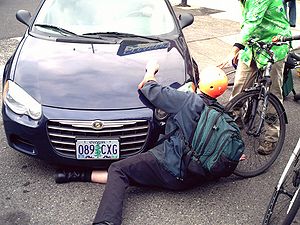Bicycling with an unskilled friend

Has this ever happened to you: you are an experienced bicycle rider. You have the spandex, the clipless pedals, the shoes, the gloves, the lights, the fenders, etc. You have put in hundreds of miles cycling around town and all over the place. You may or may not be in the greatest of shape, but you can get around efficiently and you are comfortable in traffic. You can change out a flat tire in about two minutes, and you can tune up your wheel with a spoke wrench at the drop of a hat. And then it happens: someone wants to ride with you who doesn't even know how to shift gears or inflate a tire.
And let's say that for whatever reason, you also want to ride with this person: maybe this is a love interest, maybe this is a son or daughter or mother or father. Whatever the reason is, you are motivated to ride with this individual, and you know that your patience will be stretched to the limit. How do you ride with this person in such a way as to keep your relationship in tact and to encourage their continued riding? Here are a few tips and pointers to make that happen.
Equipment
- Have a rear-view mirror. You're going to need it, because you'll be engaging in slightly riskier riding than you normally would, and you'll also be looking out for your partner's safety. Use a helmet-mounted or glasses-mounted or bicycle-mounted unit, but whatever it is, get one before you ride.
- Don't wear your spandex unless your riding partner is too. Try to dress in a similar fashion to whomever you're going with so they don't feel out of place and weird. It's okay to wear the shoes and the gloves, but leave the rest at home if they are.
- Carry the paniers or the backpack for your partner, and make sure you've packed the jackets, water, food, and repair tools that your partner needs.
Riding etiquette
Stay together.
Remember that your partner's primary goal is to spend time with you, and that riding is not their first love. They are probably not receiving nearly as much pleasure from being on the bicycle as you are, and so you need to keep in mind that your primary goal is to spend time with your partner, and not to get exercise. Chances are, that you are not going to be getting your heart-rate up or breaking much of a sweat. Get used to it. Be resigned to the fact that you will be getting little more exercise than sitting on the couch at home, and be okay with that.
- It's okay to take the lead sometimes, but try as much as possible to ride side-by-side. Sometimes that might mean getting out of the bicycle lane and into traffic (here's where the rear-view mirror becomes important).
- Another bicyclist disagrees: side-by-side bicycling holds up traffic and only encourages cars and other bicyclists to pass unsafely. Just as driving a car much slower than traffic is unsafe, so is bicycling in front of traffic when it's unnecessary.
- On the flats, never get more than about two or three bike lengths ahead of your partner.
- On the hills, be willing to stop and walk up the hill if your partner is struggling. Don't just power up to the top of the hill and wait for them. Walk with them. It might hurt your iron-ass bicycle pride to be seen walking up a hill. Swallow it. Don't try to make your partner feel guilty if they need to walk. Chances are that they already feel fairly intimidated by your strength and skill on the bike, and you don't want to rub it in. Be nonchalant about walking.
- Going downhill, be conscious that your partner might be frightened out of their mind at the speed. Be willing to hit your brakes and let them catch up to you. Even on the flats, if you have to get out in front of them to go single file, be willing to hit your brakes to let them catch up faster.
Plan your ride
Nothing is worse than taking someone on a dangerous or busy road that you have forgotten is fairly frightening and have become used to dealing with. Plan your ride ahead of time so that you will be on streets that do not present a danger to your partner. Plan also for other stops along the way: get a beer, have a coffee, go to watch a movie. Provide points of interest besides the bicycling for your partner.
Keep it social
Often in cycling groups, there is not much talking, and there is much more of a focus on pounding out the miles. That is not the case with you and your partner. Try to make conversation as much as possible.
Tips & newsy bits
- FAQ: Why do you ride like that?: “Biking in the middle of the lane like that sure looks dangerous.”
- Driving in the middle of the lane actually protects cyclists against the most common motorist-caused crashes: sideswipes, right hooks, left crosses, and drive-outs. A bicycle driver’s top safety priority is to ensure he or she can be seen by motorists with whom they might potentially be in conflict, and bicycling in the middle of a lane is one of the most effective ways to do that. Most overtaking crashes involve a motorist who attempts to squeeze past (illegally) in a lane that is too narrow to share.
External Links
- Bikes Not Bombs uses the bicycle as a vehicle for social change. We reclaim thousands of bicycles each year. We create local and global programs that provide skill development, jobs, and sustainable transportation. Our programs mobilize youth and adults to be leaders in community transformation.